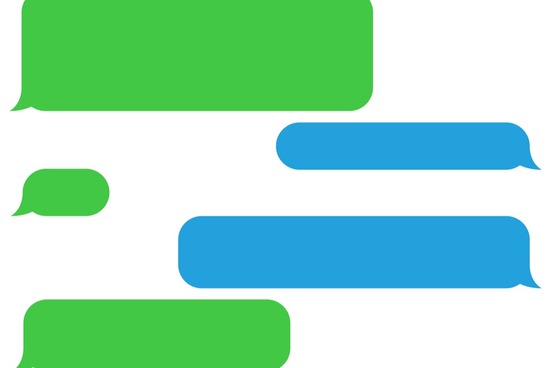
Blog
Besides being slangy in appearance and sound, there is nothing remarkable about the word blog. It is short for Weblog and its etymon conveys what it is: a log (journal) on the Web that gives an account of a person's reflections and experiences. What might pique your interest is the histories of two relatively unfamiliar homographs of blog. They have absolutely no connection to the Internet blog—or to each other, for that matter—but the fact that blog was used many years prior to the Internet is surprising to many people.
Blog is entered in the 1898 volume of The English Dialect Dictionary as a figurative use of block and is said to be "used of anything resembling a block or log of wood." This sense, now obsolete, may be found at the end of the 19th century.
Meanwhile we have our eyes on a nice li’ll blog of a horse; when we have time we will hunt about for a market cart.
—Charles Lee, Paul Carah, Cornishman (in The Leisure Hour), Feb. 1898
There is also an older verb use of blog (defined by Wright as “to look sullen or sulky”), which dates back to the middle of the 18th century.
And thee be olweys wother agging or veaking, gawing or sherking, blazing or racing, kerping or speaking cutted, chittering or drowing vore o’ Spalls, purting or ghowering, yerring or chounting, taking owl o’ wone Theng or Pip o’ t’ather, chockling or pooching, ripping up or roundshaving wone t’ether, stivering or grizzeling, tacking or busking, aprill’d or a muggard, blogginf or glumping, rearing or snapping….
—Peter Lock, An exmoor scolding, 1750
Blog can also be found in Eric Partridge's A Dictionary of Slang and Unconventional English. It is defined as 19th-century schoolboy slang for "a servant-boy in one of the houses [on campus]" and is explained as a perversion of bloke. In the 20th century, this use of blog was extended to "a common boy of the town." There is also an entry for the verb blog used in 20th-century slang as a synonym of defeat.
These forms of blog gradually faded away, but by the end of the 20th century a new homograph became prevalent in the English language, the Web blog.

Text
People have been texting since Shakespeare's time. Back then, it referred to writing in text hand—a style of handwriting marked by the use of large letters. This sense of the word also extended into figurative use.
And stratagems sore past with yron pens,
Are texted in thine honorable face,
Thou art a married man in this distresse.
—Anon., The raigne of King Edvvard the third, 1596This labour being taken, the Maister of the Motion hearkens where such a Nobleman, such a Lord, or such a Knight lyes, that is liberall: hauing found one to his liking, The Motion (with his Patrons name fairely texted out, in manner of a Dedication,) is presented before him.
—Thomas Dekker, Lanthorne and candle-light, 1609
Considering that text has been in use as a verb for hundreds of years, it is somewhat surprising that texter did not make an appearance in the language until the 19th century. Early use referred to someone who is skilled in text hand.
Wanted, a re-engagement as Engrossing and General Clerk … excellent writer and texter.
—The Law Times, 29 Mar. 1884

Virus
Biologically, virus has been an unwelcome word since the 16th century, and computationally since the 1970s. Both senses of the word denote the insertion of disruptive coded material into a normally functioning system that therein multiplies.
Virus is from classical Latin in which it referred to poison, venom, and various secretions (often pus). Its earliest known English use is in the late 14th century in reference to semen. A couple of centuries later the Latin sense of "venom" was injected into the language. It was often used literally and figuratively until the era of bacteriology.
It is meant indeed of any gaules; which is hotte poyson: But Augustine vseth it heare for the generatiue sperme, which some call Virus.
—Saint Augustine, Of the citie of God (with the learned comments of Io. Lod. Viues), 1610A Virulent vlcer is that, wherein virus, that is to saye, a certaine thinne & liquid excrement, not fretting, aboundeth.
—Johann Jacob Wecker, A compendious chyrurgie, 1585He maintained no part of Iouinians heresie, vttered no oath in any violent fervency: you straine out vires and virus, passion and poison against him, that afforded you much loue and compassion, who was a meanes to obtaine a place for you in that house, and, when some distasting you sought to work your remoue, he defended you against that storme.
—Daniel Price, The defence of truth, 1610
The modern biological sense of virus, referring to a submicroscopic infective agent, appears circa 1900.
The first known use of virus to describe a program that infects another computer is in David Gerrold’s 1972 sci-fi novel When HARLIE Was One. The program is modeled on how pathogenic biological viruses infect living beings:
"Do you remember the VIRUS program?"
"Vaguely. Wasn’t it some kind of computer disease or malfunction?"
"Disease is closer. … It was a program that—well, you know what a virus is, don’t you? … Let me put it another way. You put the VIRUS program into it and it starts dialing phone numbers at random until it connects to another computer with an auto-dial. The VIRUS program then injects itself into the new computer. … You could set the VIRUS program to alter information in another computer, falsify it according to your direction, or just scramble it at random, if you wanted to sabotage some other company."
A few years later, author John Brunner featured computer viruses in his novel Shockwave Rider in which he may have coined the use of the viral worm:
I’d have written the worm as an explosive scrambler, probably about half a million bits long, with a backup virus facility and a last-ditch infinitely replicating tail.
Being first documented in fiction, it seems virus became the de facto word for the infective computer programs after they began proliferating for real.

Cloud
Nowadays, storing data in the cloud and working in the cloud via cloud computing are commonplace. The word cloud in reference to the airy masses floating in the sky has become a metaphor for the vast expansiveness of the Internet, and it is because of medieval thinking that this figurative use of the word by tech companies exists today.
In the Middle Ages, cloud wasn't used as the name for the white or gray masses in the sky; it designated hills or masses of earth or clay.
Wormes woweþ under cloude. [Worms woo under the earth.]
—Lenten us come, circa 1325
The Old English form of the word was clūd—related to the word clod, meaning "clot" and "lump or mass of earth." Around the beginning of the 14th century, people began conceiving the formations in the sky as floating clusters of rock. That vision eventually led to the transference of the word for "mass of earth" to the masses in the sky. By the end of the 15th century, the "land" senses of cloud completely crumbled and with them any confusion as to what cloud meant.
In addition to the technological metaphor of cloud, other figurative uses have developed over the word's long history. The appearance of dark clouds, for instance, led to the use of the word for things that threaten or obscure, as in "a cloud of suspicion" or "a cloud of ambiguity."
Prudence to look up all publick counsells, so securely, so secretly, that such matters as are to be debated Communi concilio, none be present at, who lie under any cloud of suspition, none who hold any correspondency with publick enemies, who will impart the debates and resolutions of State, to such who prejudice the enterprises, and frustrate the designes thereof.
—Enoch Grey, Vox coeli, 1649

Browser
A computer browser helps us search for information on a network. In pre-Internet days, the work of a browser was done by ourselves. We browsed libraries and brick-and-mortar stores in search of information or a particular item, or we visited those places to idle away the time thinking about what we might want, much like we do now surfing the Internet. Centuries ago, the activity of browsing was done in fields and forests, and we searched for shoots, leaves, and twigs to use as food for animals in winter.
Frondátor … A woodlopper: a browser.
—Thomas Cooper, Thesaurus linguae Romanae, 1578
Animals did their own browsing as well:
>The proud Destroyer seeks no common Game,
He scorns the well finn'd Sporters of the Flood,
He scorns the well plum'd Singers of the wood;
Disdains the wanton Browzers of the Rock,
Disdains the lowing Herd and bleating Flock;
With Wolf or Bear, despizes to engage,
Nor can the generous Horse provoke his rage.
—Girolamo Fracastoro (trans. by N. Tate), Syphilis, or, A poetical history of the French disease, 1686
The name browser is an offshoot of the verb browse, which germinated from Anglo-French brouts, meaning "sprouts." The word was used solely for a forager until the 19th century, when the verb browse began being applied to other types of wandering and searching, such as that which is done in a library or bookstore, where food for thought is sought by the browser but the browser doesn't know what he or she is in the mood for. Early uses of browse in this sense often mention browsing in nature as a counterpoint.
A Writer whom we consulted last year on this business observed, "the students have probably long ago obtained as binding a servitude of browsing upon this library as any man ever had of grazing his cattle upon a village common."
—Blackwood's Edinburgh Magazine, January 1818 She was tumbled ... into a spacious closet of good old English reading, ... and browsed at will upon that fair and wholesome pasturage.
—Charles Lamb, "Mackery End," 1823 By the century's end, browsing became ubiquitous in the marketplace where the browser casually wanders without serious intention of buying anything. The bookshop browser also became the book browser, perusing a book's contents without serious thought. It was probably the latter activity that led to using browse for the act of viewing information on a computer in the 1960s and, hence, naming the invention enabling such activity browser.

File
A computer file is defined as "a collection of data treated as a single unit." The origin of that use of file goes back to the days of handwritten documents when the word meant "a collection of papers placed on a file." The phrase "on a file" is intentional: in the past, file referred to a wire or cord on which documents were strung for preservation and reference—a practice that goes back to the early 16th century.
Thapothecaries shall kepe the billis that they serve, upon a fyle.
—Vicary's Anat. Bodie of Man, 1525Burning all the unnecessary letters which I have had upon my File for four or five years backward.
—Samuel Pepys, Diary, 9 Dec. 1666
The word is a borrowing of French fil, meaning "thread," which itself is from Latin filum, of the same meaning.
File has since come to refer to other means of storing a collection of documents in an orderly way, like folders and cabinets, and a wire isn't necessary for filing—nowadays, you don't even need one to access your computer files.

Code
In the 21st-century, it might be hard to fathom that code, a name for computer instructions, is based on a word for the trunk of a tree as well as a block of wood covered with wax for writing. That root word is Latin codex, which also came to mean "a book of laws" from its earlier "wooden writing tablet" sense. French adopted the Latin word and formed code as a name for a system or book of laws, and English borrowed the French word in the early 14th century.
In English, code specified the statutes made by Roman Emperors—for example, "the code of Theodosius" and "the code of Justinian." It wasn't until the 18th century that the word was extended to laws of other political bodies and subsequently to any set of rules, customs, or regulations. The concept of a social "code of honor" originated in the latter half of the 18th century.
I shall make a short Dissertation upon the three Codes of Law so often mentioned by the ancient Historians.
—Thornhagh Gurdon, The history of the High Court of Parliament, 1731But this law, Mr. Lewis, you have manifestly broke; and though the code of honour might have overlooked it in the world at large, on board of ships at sea, the infringement of it must be guarded against with peculiar care.
—Robert Bage, Mount Henneth, 1788
By the 19th century, the British military began to use a "code" in communication. The code was a system of words assigned arbitrary meanings for brevity and secrecy and was used in telegrams. (This system predates the Morse code, which was invented during the 1830s.) The codes gradually became more creative and, in turn, more cryptic, assigning meanings to individual letters, numbers, and other symbols. This coded language was the precursor of computer code, which originally consisted of symbols that introduced information and instructions into a computer by being punched onto cards—a much better option than being etched into wax.

Firewall
Today, people recognize firewall as the name for hardware or software that protects networks or computer systems from unauthorized access or manipulation by outside computer users, and they don't immediately associate the term with its base words, which suggest "a wall of fire." The earliest record of that literal meaning is from the 16th century, but more than likely it is much older.
In the mid-1600s, firewall named an earlier form of protection: an innovative wall made of noncombustible material to prevent the spread of fire. Such walls completely separated two parts of a building from the basement to above the roof.
There may one wall be raised between them … which for distinction may be called the Firewall, that in case of accident the fire come into any of the storehouses, its further progres may be stopped.
—F. Lodwick, On Language, Theology, and Utopia, 1666Every dwelling house … shall be made and constructed of stone or brick, with … fire walls rising twelve inches above the roof, and shall be covered except the flat roof with tile or slate….
—Laws of the state of New-York, Fourteenth session, 1791
By the 20th century, firewall was applied to anything created to provide security by acting as a barrier or safeguard.
His strategy was to lock into place a political firewall in the Midwest to prevent any late surge by Democrat Michael Dukakis.
—Jeffrey H. Birnbaum, Wall Street Journal, 8 Nov. 1988Authorities hope that a large infusion of cash into the financial system, if needed next week, could act as a financial firewall to help protect shakier banks in Southern Europe.
—Nelson D. Schwartz and David Jolly, The New York Times, 16 June 2012… professional societies could issue guidelines calling for firewalls to keep marketing out of patient visits—as they did with free pens and other traditional marketing tools….
— Christopher Manz et. al, The New England Journal of Medicine, 13 Nov. 2014
Computer engineers began erecting firewalls as protection against viruses, hackers, and other unwanted virtual intruders by the 1970s.

Cursor
Nowadays, we know cursor to signify the movable indicator on a computer screen. The word is a Latin borrowing meaning "runner"—based on currere, meaning "to run," which is also the source of English course—and was originally used in medieval English to refer to someone who delivers messages.
But the Popes Cursor beyng not the hardyest man (belike) that euer shewed his head, thought it much more sure for him to discharge his Popishe carage without the kynges reach, & so keepyng himselfe aloofe of (like a prety man) set vp his writynges in the Towne of Dunkirke in Flaunders.
—John Foxe, Actes and monuments, 1583
In the late 16th century, scientists applied the word to the sliding part of a slide rule or other similar instrument that is used to align corresponding points on marked scales. It is likely that this use of cursor influenced the name of the visual cue on a computer screen that is moved to indicate the position for entry of data or manipulation of information.
Let the Cursor now carrie one quadrant of 90 deg. serving chieflye for the Azimuthes, and therefore called the Azimuthall quadrant, numbred double vz. upwards and downewards….
—John Blagrave, An apollogie confirmation explanation and addition to the Vranicall astrolabe by the author, 1597






